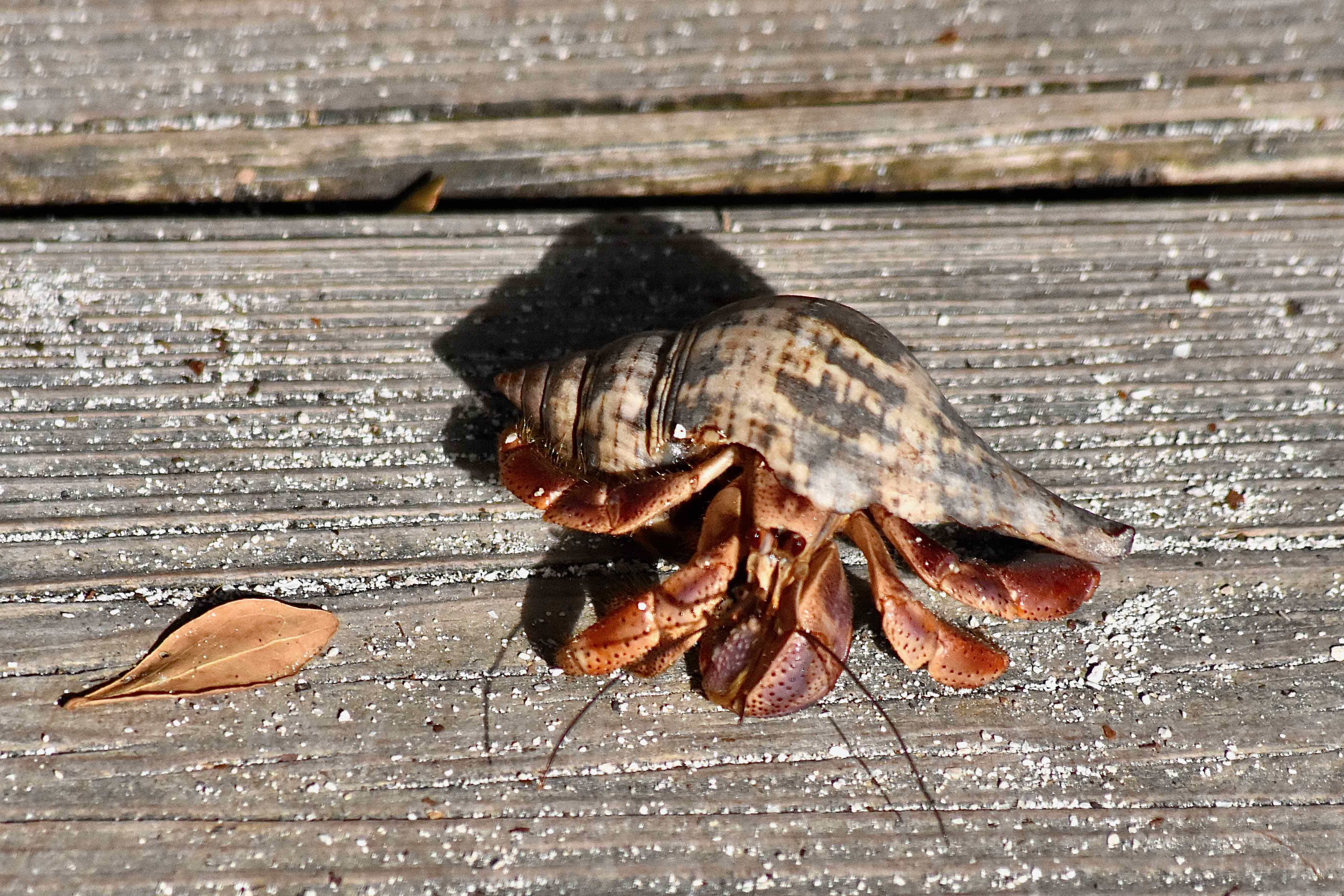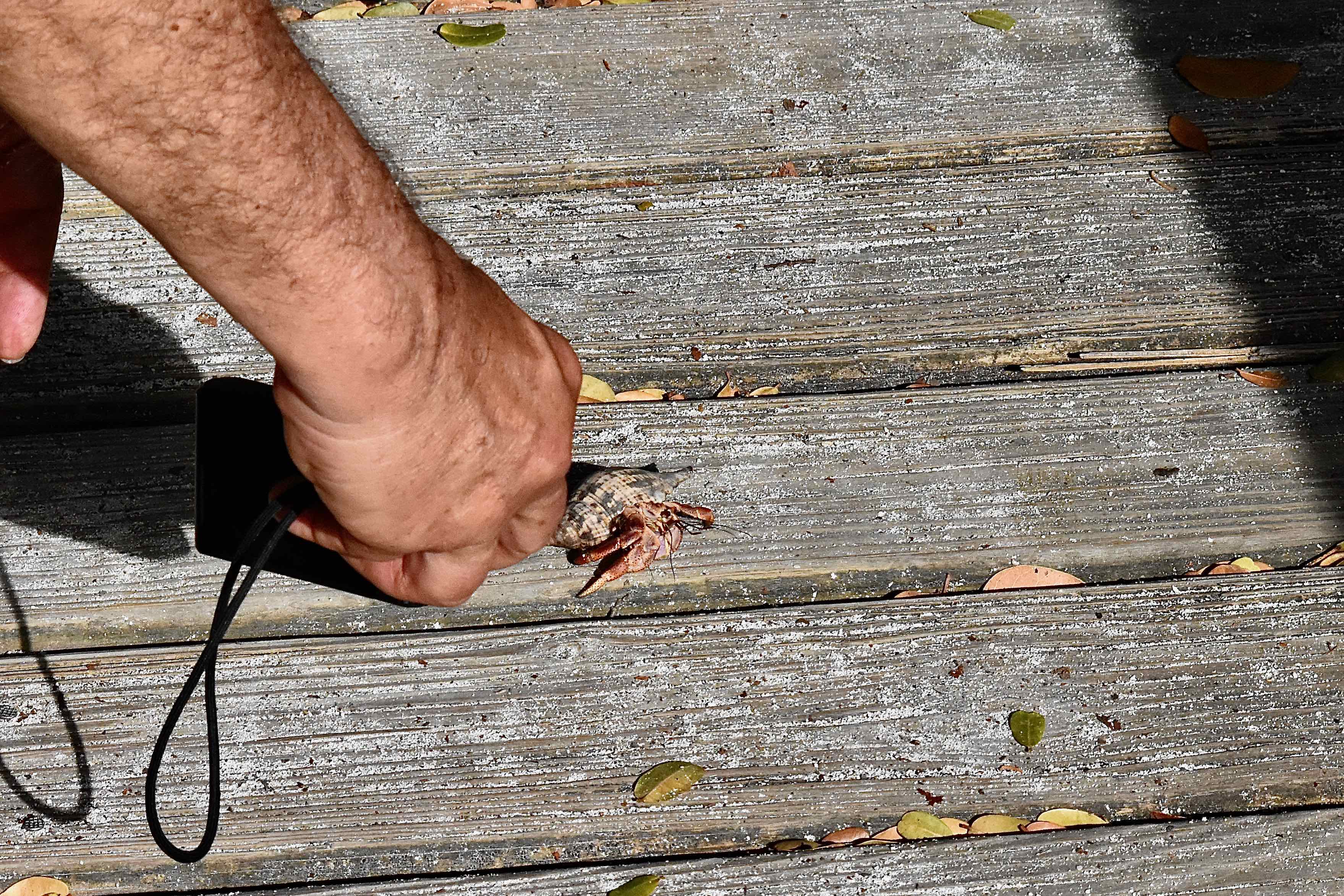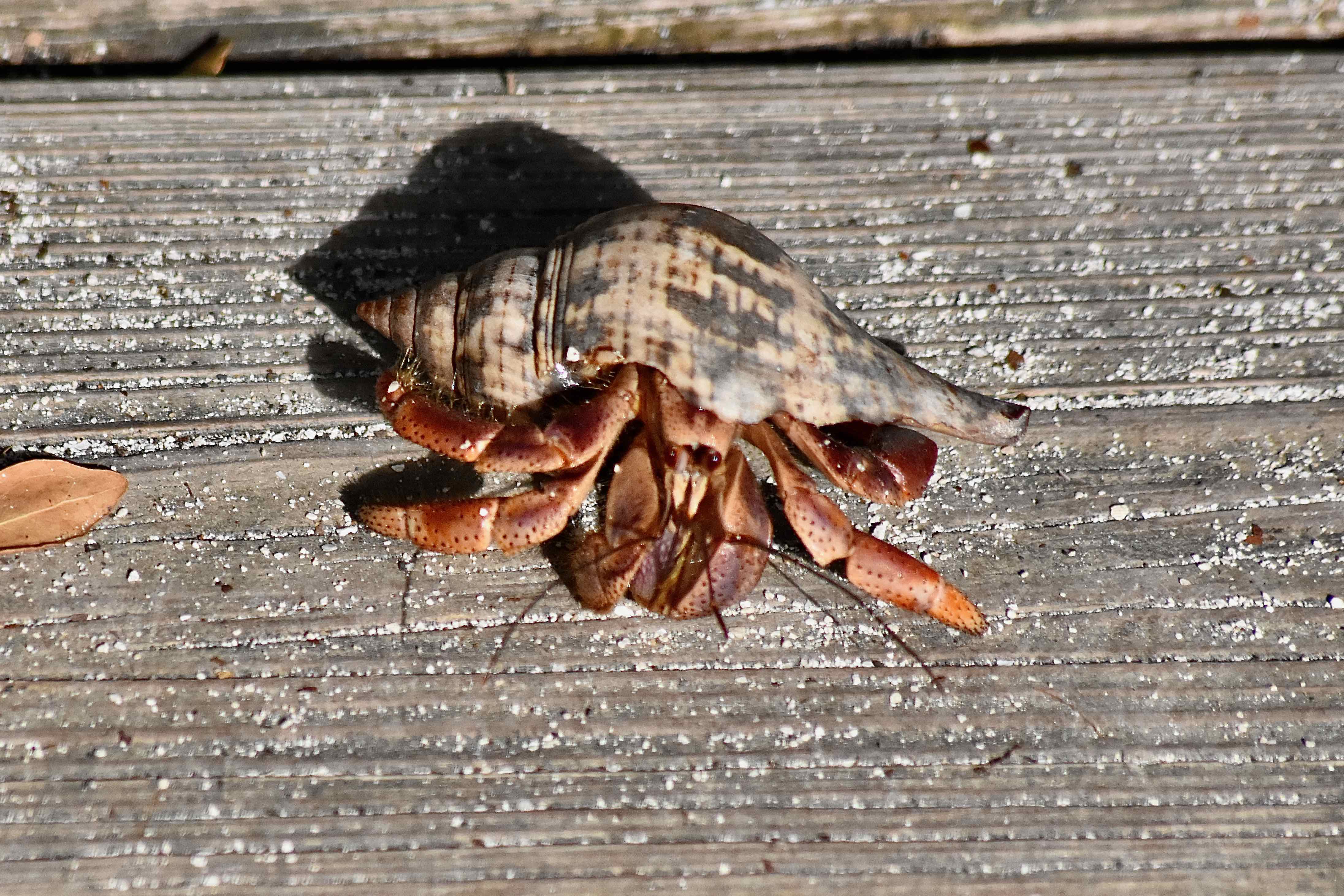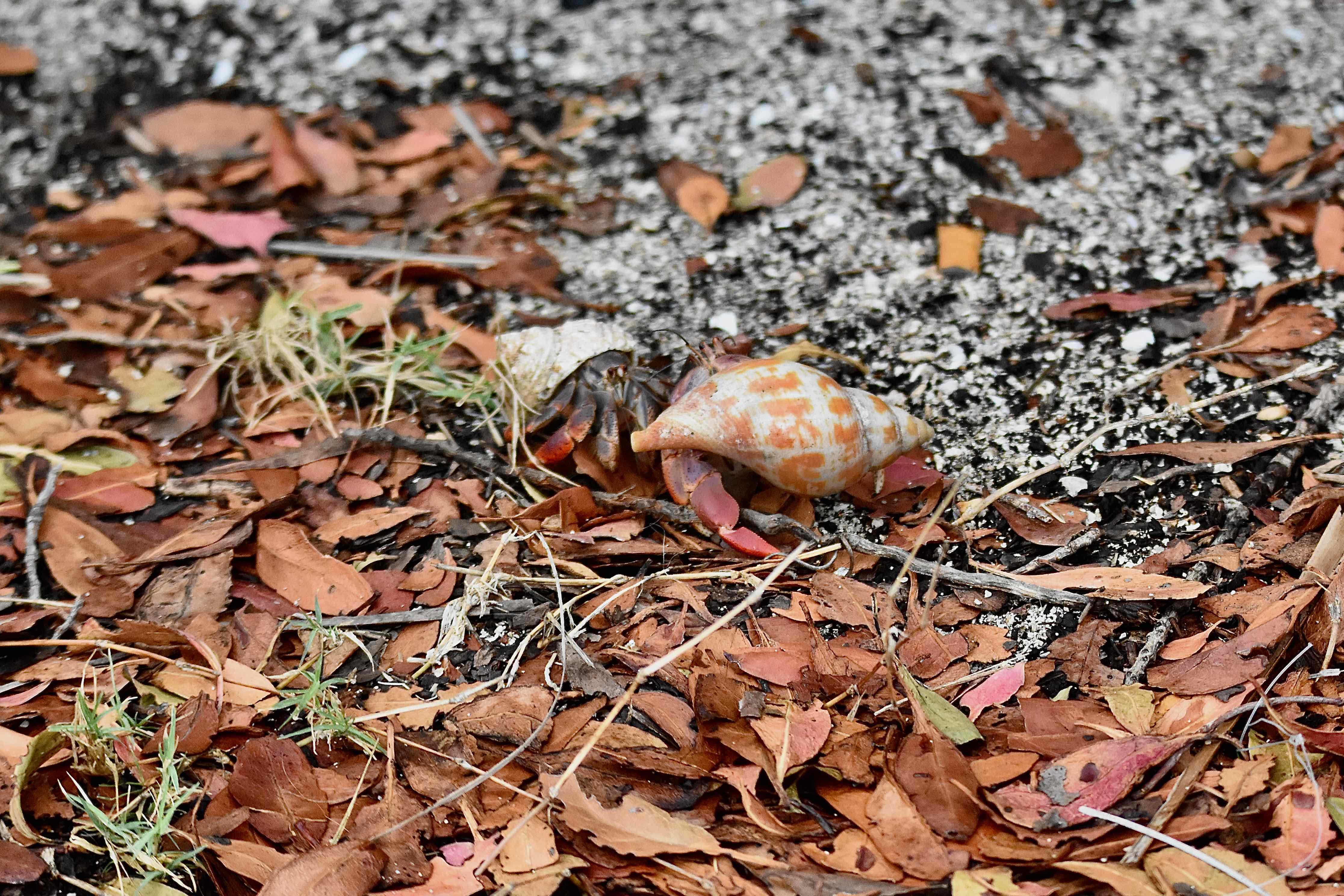
Caribbean land hermit crab, photographed at Long Key State Park, Layton, Monroe County, in April 2017.
Question: How do you tell the difference between a west Atlantic hermit crab, a soldier hermit crab and a Caribbean land hermit crab?
Answer: You can’t. Trick question. They’re various names for the same critter, scientifically known as Coenobita clypeatus. We’ll go with Caribbean land hermit crab, since it’s fairly descriptive in a number of ways.
The Caribbean land hermit crab is one of 800 species of hermit crabs worldwide and one of about nine native to Florida. Their range extends as far south as Venezuela, through the Caribbean, parts of Central America, the Bahamas and Bermuda.
It's also one of the most common of the hermit crabs, but it can be rare in parts of its range, particularly Bermuda, where a scarcity of shells limits the size of the population. More on that in a bit.
It is a semi-terrestrial animal, living the first portion of its life in the ocean but as an adult, it lives on land. It’ll return to the water only briefly to deposit its offspring before returning to its terrestrial haunts. And while it can get around quite well on land, it still has gills that need to be kept wet in order to breath. It solves the problem by carrying a supply in its shell.
First thing to known about these guys is that they’re not true crabs, rather they’re more closely related to lobsters. That they need to use a shell instead of producing their own is a major clue that they’re not a true crab.
Like all hermit crabs, the bodies of Caribbean land hermit crabs are not entirely covered by a hard outer layer found on true crabs — their tail is left vulnerable to predators. They solve the problem by picking up the shell of a deceased mollusk and using it as their home. Their tail is curled and hooked, which allows them to grab and hold onto the shell.
As they grow, they’ll drop their old shell and use a larger one, their old shell likely to be used by a smaller crab. Caribbean land hermit crabs will get aggressive with others over shells, even stealing them.
They have five pairs of legs. The first pair are called chelipeds and come equipped with claws. The left is larger than the right and is used for fighting other Caribbean land hermit crabs, as well as shielding itself from predators as it curls inside its shell. The smaller right is used for feeding. The other four pair of legs are called periopods, and are for movement.
Caribbean land hermit crabs are found in a variety of habitats, including mangrove swamps, coastal forests and wetlands. They spend their days hiding in vegetation, in nooks, even in tree holes, any place that keeps them away from predators. At night, they become active. They are omnivores and they are scavengers. They’ll eat fruit as well as decaying plant and animal remains. Even poop can be on their menu.
At certain times, they’ll migrate en masse to the sea in order to mate; fertilized females will deposit hundreds, even thousands of eggs at a time. As they eggs hit the water, they burst open and the larvae will swim off, munching on plankton until it’s time to return to land. Assuming they live that long.
The Caribbean land hermit crab population depends on a ready supply of shells. In Bermuda, it relies heavily on the shell of West Indian topshell snails. Unfortunately for the crab, the snail was a favorite food of the island’s early settlers who ate them until there weren’t any more. In other words, extirpated. In 1982, the snail was reintroduced in Bermuda and given legal protections; the population is increasing and the hope is the crab population will follow.
In an odd way, hermit crabs have the same problem here in Florida. No, we’re not eating a favorite mollusk into extinction. Rather the crabs have to compete with shell-collecting tourists for their homes, and that, to some extent, limits there numbers here.
One of the serious threats to hermit crabs generally, including our guy, is garbage. Seriously. It’s been estimated 570,000 hermit crabs die annually by getting caught in plastic debris on just two islands in the Pacific. When they die, they release a pheromone that signals other hermit crabs that a shell might be available. When it’s plastic debris that they’re trapped in, they’re essentially luring other hermit crabs to their deaths.
A second threat: the pet trade. This is a threat generally to hermit crabs, but Caribbean land hermit crabs illustrate the problem. They can live decades in the wild — we’ve seen various estimates, one as long as 40 years — but that trickles down to a few months in captivity. Hermit crabs don’t breed well in captivity, meaning that virtually all the crabs being sold on the market are taken from the wild.
And a lot of hermit crabs are sold annually. It’s an unregulated business, so precise numbers are nonexistent, but according to a story in the New York Times written in 2000, one New Jersey dealer said he sold more than a million each year. And most of those sold are Caribbean land hermit crabs. Dealers claim is that these animals require minimal care in order to thrive when the opposite is true.
Given the sheer numbers, the practice is unsustainable. A few might end up in the hands of hobbyists and others who know how to take care of them. Most will not.
Other names for Caribbean land hermit crabs include purple pincher, tree crab, Caribbean hermit crab and land hermit crab. it is a member of Coenobitidae, the family of land hermit crabs.
Long Key State Park. Bottom left photo taken at Dry Tortugas National Park.
Answer: You can’t. Trick question. They’re various names for the same critter, scientifically known as Coenobita clypeatus. We’ll go with Caribbean land hermit crab, since it’s fairly descriptive in a number of ways.
The Caribbean land hermit crab is one of 800 species of hermit crabs worldwide and one of about nine native to Florida. Their range extends as far south as Venezuela, through the Caribbean, parts of Central America, the Bahamas and Bermuda.
It's also one of the most common of the hermit crabs, but it can be rare in parts of its range, particularly Bermuda, where a scarcity of shells limits the size of the population. More on that in a bit.
It is a semi-terrestrial animal, living the first portion of its life in the ocean but as an adult, it lives on land. It’ll return to the water only briefly to deposit its offspring before returning to its terrestrial haunts. And while it can get around quite well on land, it still has gills that need to be kept wet in order to breath. It solves the problem by carrying a supply in its shell.
First thing to known about these guys is that they’re not true crabs, rather they’re more closely related to lobsters. That they need to use a shell instead of producing their own is a major clue that they’re not a true crab.
Like all hermit crabs, the bodies of Caribbean land hermit crabs are not entirely covered by a hard outer layer found on true crabs — their tail is left vulnerable to predators. They solve the problem by picking up the shell of a deceased mollusk and using it as their home. Their tail is curled and hooked, which allows them to grab and hold onto the shell.
As they grow, they’ll drop their old shell and use a larger one, their old shell likely to be used by a smaller crab. Caribbean land hermit crabs will get aggressive with others over shells, even stealing them.
They have five pairs of legs. The first pair are called chelipeds and come equipped with claws. The left is larger than the right and is used for fighting other Caribbean land hermit crabs, as well as shielding itself from predators as it curls inside its shell. The smaller right is used for feeding. The other four pair of legs are called periopods, and are for movement.
Caribbean land hermit crabs are found in a variety of habitats, including mangrove swamps, coastal forests and wetlands. They spend their days hiding in vegetation, in nooks, even in tree holes, any place that keeps them away from predators. At night, they become active. They are omnivores and they are scavengers. They’ll eat fruit as well as decaying plant and animal remains. Even poop can be on their menu.
At certain times, they’ll migrate en masse to the sea in order to mate; fertilized females will deposit hundreds, even thousands of eggs at a time. As they eggs hit the water, they burst open and the larvae will swim off, munching on plankton until it’s time to return to land. Assuming they live that long.
The Caribbean land hermit crab population depends on a ready supply of shells. In Bermuda, it relies heavily on the shell of West Indian topshell snails. Unfortunately for the crab, the snail was a favorite food of the island’s early settlers who ate them until there weren’t any more. In other words, extirpated. In 1982, the snail was reintroduced in Bermuda and given legal protections; the population is increasing and the hope is the crab population will follow.
In an odd way, hermit crabs have the same problem here in Florida. No, we’re not eating a favorite mollusk into extinction. Rather the crabs have to compete with shell-collecting tourists for their homes, and that, to some extent, limits there numbers here.
One of the serious threats to hermit crabs generally, including our guy, is garbage. Seriously. It’s been estimated 570,000 hermit crabs die annually by getting caught in plastic debris on just two islands in the Pacific. When they die, they release a pheromone that signals other hermit crabs that a shell might be available. When it’s plastic debris that they’re trapped in, they’re essentially luring other hermit crabs to their deaths.
A second threat: the pet trade. This is a threat generally to hermit crabs, but Caribbean land hermit crabs illustrate the problem. They can live decades in the wild — we’ve seen various estimates, one as long as 40 years — but that trickles down to a few months in captivity. Hermit crabs don’t breed well in captivity, meaning that virtually all the crabs being sold on the market are taken from the wild.
And a lot of hermit crabs are sold annually. It’s an unregulated business, so precise numbers are nonexistent, but according to a story in the New York Times written in 2000, one New Jersey dealer said he sold more than a million each year. And most of those sold are Caribbean land hermit crabs. Dealers claim is that these animals require minimal care in order to thrive when the opposite is true.
Given the sheer numbers, the practice is unsustainable. A few might end up in the hands of hobbyists and others who know how to take care of them. Most will not.
Other names for Caribbean land hermit crabs include purple pincher, tree crab, Caribbean hermit crab and land hermit crab. it is a member of Coenobitidae, the family of land hermit crabs.
Long Key State Park. Bottom left photo taken at Dry Tortugas National Park.



